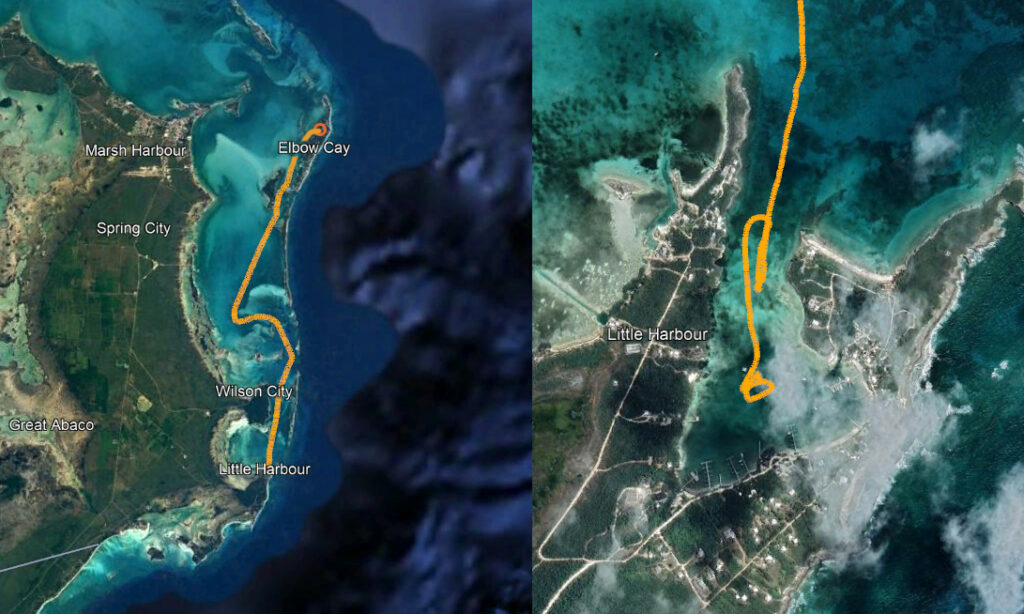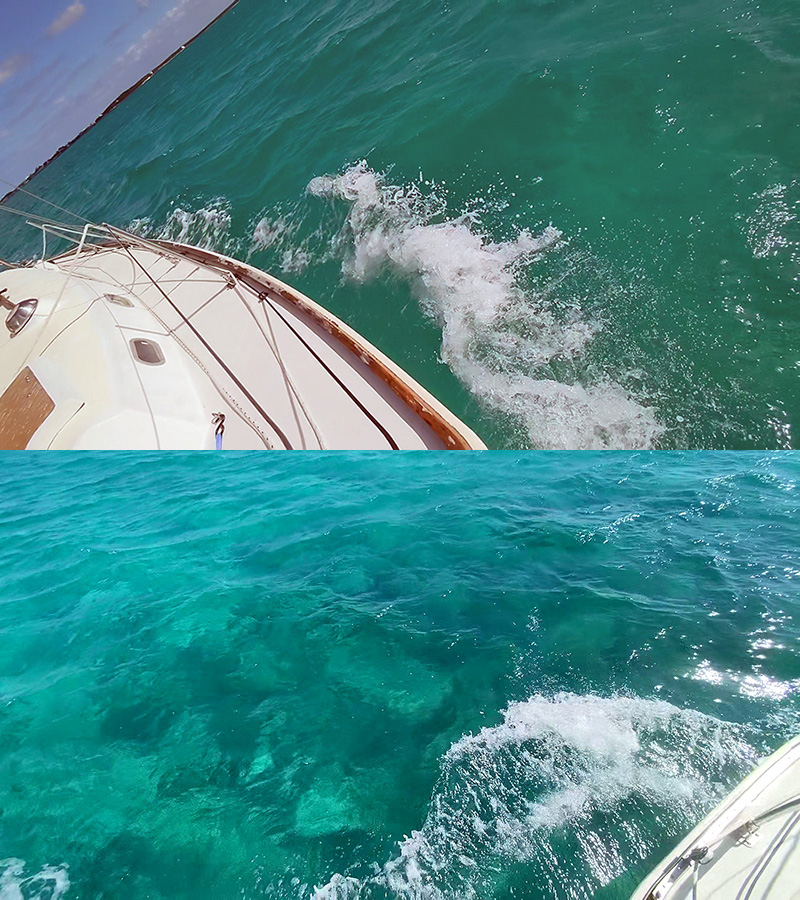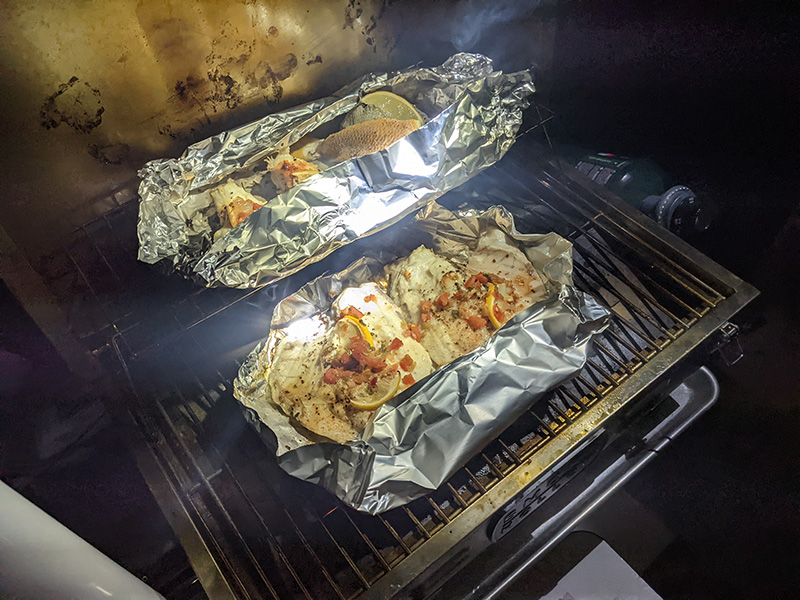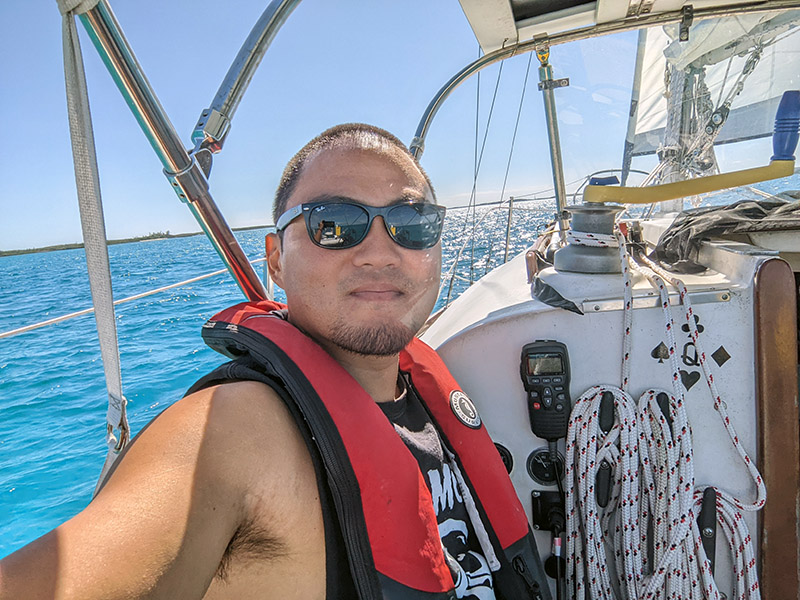I was halfway through my trip at this point! There were moments of boredom on this cruise. I imagine there always will be some of these moments when you cruise for more than a few weeks. I found myself missing home, my cat, my friends, and the regularity of every day life. I have a confession to make. I am a huge aviation nerd. I play this ultra-nerdy flight simulator game on my PC back home. I really missed this and I was watching a lot of naval aviation content on YouTube when I had down time. In other words, I was starting to miss the silly things I did to keep myself entertained during moments of boredom back on land.

So what was I doing half way mark of this this trip? I was actually sailing. From Elbow Cay to Little Harbour. I wasn’t sure how cool Little Harbour was going to be. Most cruisers skip it. Others rave on about its charms. There was only one way to find out. Although there is no place to get fuel or water there, it would at least make a good rest stop before making the passage to Eleuthera.
I love sailing. Winds blew in the high teens. The sun was shining and the sky was a brilliant blue. With my brand-new sail inventory, even with two reefs in and about eighty percent of the genoa out, I was making near top speed. I could shake out the reefs, depower them a bit, and make close to seven knots, but for this short three hour passage, why not settle for six knots. This fancy, brand-new headsail really brings my boat up to a blistering speed.
I had to make several direction changes, so it was a busy passage. What a welcome change of pace. I almost caught up with a big fancy charter catamaran. I actually met them later – a young couple on a honeymoon trip on the rented yacht. Looked to be about my age. They were only in the Bahamas a week, so they were making a quick stop. All of these charter-cats make quick stops. How unfortunate. I think I would rather make a weeklong stop at one harbour than spend my time busily hopping between as many islands as possible. But I guess that is what you do if you want to pay that much money to be on a floating condo, which is to say, somehow different from simply being on a sailboat in the Caribbean.

I saw a seaplane fly above me. I wondered if they were going to land on the water somewhere. Then I saw a fishing trawler motor by, with four Boston Whalers skiffs behind them, all under power. The smaller boats were using the flat waters behind the wake of the fishing trawler. I’ve been trying to figure out what that was. I thought it could be a cluster of unrelated boats taking advantage of a situation. How cool.
I spent a lot of time looking at the water going by Sonora. The ‘silk’ left a gentle spray as Sonora’s bow cut a path for herself through the surface. Patterns made of different color by as the boat went over different submarine terrain. A little bit abruptly and a little bit gradually, the sea floor had an even more brilliant color as I headed into the even clearer waters of the South Abacos. People have been telling me that this would happen as I headed further south. In deeper water, the water was this aquamarine blue. As it got shallower, it’d just be the color of whatever the seabed was. Brown for grass, darker brown with splotches of different colors for reef, and an incredible, pink-ish white for sand.

It really looked like a scene from a commercial. A seaplane overhead. Fishing boats and fancy catamarans. Sometimes even a moderately-sized motor-yacht. And my classic looking, private passage maker, with both sails up and moving along at a good pace. Crystal clear waters and wind blowing in my very short hair. And up ahead, Little Harbour was approaching.
One thing about the Bahamas is that its hard to get proper tide information. The tide measuring stations are far apart. You find the closest one and do your best. And the charts often have outdated information, and user-reported soundings are unreliable. From what I’ve seen, Little Harbor was supposed to be two hours ahead of the nearest station, which is the Pelican Cay station, some miles north of Little Harbor. This was incorrect. It was also a full moon that night, bringing tides a few inches below mean low low water.
But I had gotten cocky. I have a full keeled boat that only draws four and a half feet. I’ve made it into weird, sketchy anchorages so far. And with the best information I had at the time, water should be five feet at the shallowest. But of course, I wasn’t exactly surprised when my boat softly came to a stop, engine still turning the screw pointlessly. The grassy and sandy bottom looked awfully close, but it had looked awfully close even when my boat wasn’t grounded.
Great. Instead of a few hours before low tide, I had come in at the beginning of the lowest water level. My sounder showed 4.3 feet of water at the keel, and my boat was teeter-tottering on a grassy ledge. Moments like this, I question whether I’m a competent sailor. This is absolutely not the only time I’ve been grounded. I need to be more patient and make better decisions, whether I was in the Chesapeake Bay or the Sea of Abacos.
But I wasn’t completely incompetent. If this was a questionable channel at high tide, I wouldn’t have bothered coming here. It is better to attempt questionable channels at low tide. And if it was a rocky or otherwise hard bottomed channel, I wouldn’t have tried this either.

I sat at my boat for a few hours, while other cruisers on dinghies came out and gave me unsolicited advice. Much like the advice I saw on crowdsourced apps about the harbour entrance, you really have to weed out the useless advice from good advice. One guy told me to get an halyard out to heel the boat further. What? Why stress the rigging when I could simply wait a few hours? Others went by, each with a little piece of advice with varying degrees of sensibility, but none worth the effort. One cruiser came by and told me he hand-sounded the channel and told me which side of the channel I should be on. Gut instinct told me that was the most experienced guy.
Turns out that cruiser’s name is Steve, and he was on a 1930’s vintage ‘motor-sailor’ wooden ketch that I’d been seeing since Man-O-War cay. After Sonora had become free, I immediately immobilized her again with her anchor. I motored up to him and chatted for a bit. I bobbed up and down on my dinghy next to his beautiful boat. I got the impression that Steve and his partner really liked their privacy, but I asked if they were into spearfishing – and they were! We planned to go out diving together another day. I was really excited to finally go out with someone experienced at it.
When I pushed off from his boat, I said ‘Hey Steve, look!’ and Steve went ‘Jacklyn, look!’ There was a big and dark grouper hanging out under the boat. Much bigger than the one I speared at Powells Cay. Probably four feet end-to-end. Even as my zodiac drifted away, it stayed there. I wondered why it preferred to be there instead of being under the much bigger boat. Starting my outboard finally made it leave. I guess this one liked my zodiac. Groupers are funny with distinct personalities. This one’s name was Luis, and it was the harbour’s resident grouper. You don’t spear Luis. He is like the harbour barn cat, except he is a fish, so you can’t actually pet him.

I went out by myself the next day, exiting the harbour on my little zodiac and travelling a few miles towards the barrier reef. I had trouble figuring out where the reef was. I saw brown patches, which turned out to be grass. I got as close as the waves breaking over the reef as I thought would be safe, and dropped the anchor. The first plunge into the water to set the anchor revealed a breath taking view that was new to me.
The water was as clear as any swimming pool. The colors at the seabed horizon was a gradient. From white, near the surface, to a deep blue. Then the white of the sand abruptly ended this gradient. There was some gentle topography, as the grassy patches resisted the ever-present erosive forces, but the bare sand did not. It created little dunes of grass and sand, complete with ledges and valleys all across the sea floor. Some of the ledges created by these forces were up to four feet higher on one side.
Lots of little fish were swimming about, as if they were pelagic species. Mostly baby jacks. They’d school around in loose groups, then make a sudden climb towards the surface, and snap their mouths open in synchrony with other fish. They must have been getting at plankton and fish fry. How do they see their microscopic prey? It made for a darling view. Little slivers of silver darting up and down, creating some sort of mesmerizing pattern to look at.
It was a good twenty feet to the bottom, but the dinghy anchor stayed put. I grabbed my spear from my tender and went back in. This time, I saw a school of very large jack in the distance. They were swimming towards me, much like the smaller ones often do.
They are curious about this new, lumbering fish that just joined their world with a clumsy splash. Fish will swim near you, as if debating whether to school with you or not. Will this big creature have scraps of food? Will it deter other predators? Is this strange creature a friend?
They had no fear. A few formed up on my side, as if joining in on formation. Others made a circle, swimming in front of me to look me in the eye. Wow, what a great chance to fire my spear into these friendly animals. But the contact was incredibly endearing. As I marveled at the duality between my desire to kill one of them and my appreciation of the beautiful creatures, I looked up and down the school. There was a big, brown shark at the tail end of the school, schooling with the jacks. It had a bit of a dog-like face, which reminded me of dogfish. Of course, this shark was too big to be a dogfish. It was about my size but much longer if you count the tail. A big nurse shark.
At the time I wasn’t sure if it was a nurse shark, but it certainly wasn’t a tiger or bull shark. But it was huge. I was afraid of it. It seemed to get curious and cautiously, it swam closer and closer to me. I forgot all about my conundrum.
The waters here were extremely clear. Central and northern Abacos, by US standards, were clear as well, but not like this place. I’m talking about swimming pool clear. And the white sand and bits of dead coral reflects plenty of light, extending visibility to perhaps a hundred meters or so.
So imagine if you will, a school of large, beautiful fish swimming all around yo

u in the extremely clear water. The smaller ones shimmer brilliantly in the unrestricted sunlight. Underneath the blue, a second sea of sand, broken shell, coral, and grass extending far enough to seemingly create its own horizon. And perhaps fifteen meters away, this big brown shark. Swimming lazily towards me, in an almost serpent like manner.
Its weary movement made me realize that it was probably as apprehensive as I was. But curiosity had overcame its cautiousness. It was actually wonderful seeing this powerful animal take an interest in me. Still, I was here to hunt fish, and I didn’t want a shark near me. I really wanted to nail one of these jacks. They were so close to me, and big enough to be a personal trophy. But Fish thrash about when they are hit with a spear; complete with bubbles, blood, scales and all. This agitates a shark. A ship’s whistle, signaling dinner time, if you will. It was probably a very bad idea to hit a fish in a school that included a large shark.
Even the most primitive animals understand how threatening a pointy sharp stick is. And these sharks far from mindless– they are intelligent animals. I kept my spear pointed at it, which seemed to make it think twice about getting closer. Then I started to swim towards it. The shark turned around, swam away and hid behind a grass ledge. I probably made the right choice not to spear the other fish.
After the shark went away, I moved my zodiac a few hundred yards in an attempt to find the reef. I finally found the big reef structure. It sloped to an end, with some additional clusters of reefs a bit further apart. The reef was absolutely thriving, with soft coral everywhere with a high density of colorful fish.
Parrotfish seemed to be the busiest, and the most noticeable species. Some of the big ones patrolled the reef like the snapper and jack do. The others were busy guarding their holes, chasing other conspecifics away, and eating bits of coral. They made tiny puffs of white in front of them as they spat out pieces of sand. It finally dawned on me why they are named parrotfish. With their colorful plumage of scales, they propel themselves primarily with their pectoral fins. They look like comically large bodied parrots clumsily flapping their wings through the reef. How cute!
The snapper spent time moving from hole to hole, schooling in large groups. In contrast to the bickering parrotfish, the snapper didn’t seem to mind schooling with their not-quite-the-same friend snapper species. The ones big enough to be enticing to me were very shy and quick to hide into a hole. I followed one into a hole and peeked in. It was there, hiding in a hole next to a jack that I had missed earlier. They floated in the hole next to each other, staring at me. One was probably telling the other to keep away from me.
I spent a few hours at the reef admiring all of these animals. I wish I knew more about coral. I think it would have doubled the joy I get from reef-diving. I took a lot of shots at different fish, but I missed a lot. My spear point was rapidly deteriorating as it didn’t miss the rock behind the fish. Also, my hands were getting tired and I could barely hold a loaded spear. It took some effort to continue the hunt.
One of the shots I took ended up hitting a medium sized snapper in the head, but at the upper leading edge. It definitely stunned the fish, but not enough to keep it from thrashing. It did a wild circle while it was dazed. Then it found its bearings, and took off. My spear had taken a chunk out of its head and it did not look like a survivable injury. I tried to get it again, but it got itself deep into a hole. I know this fish will eventually get eaten by something else and that nothing would be wasted. After all, what is the difference if I eat it or another fish eats it? I still feel really bad for needlessly harming a fish.
Eventually I gave up on the reef I was at, and I moved to one of the smaller reefs. At this reef, I took two smaller snappers, a small black grouper, and a decent sized yellowfin jack. The grouper was a tail shot, but the others were head shots. I shot the yellowfin right through the head, just behind and under its eyes. One of the snapper was right through the gills. All quick-killing, ‘stone’ shots. I guess my aim was improving after all.

I was going to be forever torn with the conflicting emotions in my head. Part of me really admires these animals and feels a lot of remorse for interrupting and taking their lives. The other part of me, really enjoys hunting and can talk in a semi-morbid sense about how I shot it, how accurate I’ve been, et cetera. But both of these feelings are still consistent with my philosophy – I’ll always eat meat from live animals. I find them delicious and also the fastest way to replenish my body. And if I’m not willing to experience these conflicting emotions to kill and eat my own game, I shouldn’t be eating meat at all. Turns out that I’m a human after all, and while being fully aware of what I’m doing, I thoroughly enjoy doing this without dehumanizing these creatures. And I do it with my own lungful of air in a hostile environment with a very primitive weapon. Its as sporting as hunting can be. Plus, this sure beats eating store bought meat on the ‘humanity’ scale — its by far much more humane with much less suffering of the prey animal. It even beats angling. Its probably the most targeted, sustainable and humane way to get meat.
A couple that I had met at Green Turtle Cay, Bill and Tracy, was my anchorage neighbor again. When I came back to the harbour, Bill was really eager to clean and prep the fish, and I was really happy to hand over the fish. That evening, I was really happy I left them to do the cooking. Turns out Bill is an excellent chef. After the sun set, we ate the fish together. We exchanged stories about our trip. I liked listening to Tracy tell me about her life in Hawaii. All four species of the fish were delicious. Grouper, as usual, is a bit buttery. The jack reminded me of a less strong smelling mackerel. The snapper were almost sweet, with a soft texture, though I could not distinguish the species of the two snappers by the taste alone. As an added bonus, I got to enjoy a more complete set of tableware with a much less spartan ambience compared to Sonora. Thank you Bill and Tracy.
What a great way to end the beginning of the stay in Little Harbour. I was really looking forward to exploring the land and doing some more hunting. Needless to say, I went to sleep extremely satisfied, with a belly full of fish to replenish my tired body.

Unrelated boats – Turns out that this is how people harvest lobster (crayfish) in the Bahamas. A bunch of skiffs follow, or sometimes get towed, by the bigger fishing boat. When they arrive at a location, the skiffs each leave to check on different lobster traps and condos
‘Incorrect’ – Tide at Little Harbour is a lot closer to give or take 45 minutes from Pelican Cay tide station, depending on what other factors such as wind is affecting it.
Mean Low Low Water – A type of tide datum. A semidurinal tide cycle has two low water levels. Take the lower of the low water level measurements over a time period called the National Tidal Datum Epoch to calculate the mean levels. Did you pay attention in middle school math class? The mean and an average of a given set of numbers are different. I will let you look that up yourself!
Steve – Steve is a well known shipwright that is based out of Annapolis. Steve and Janice have many friends that have crossed paths with their journies on Steadfast!
Right choice – Bruce is a friend met in Marsh Harbour. I call him my Caribbean Dad because of all the cruising wisdom he has given me. He has a story where he speared a large fish in front of a few sharks. Bruse said he launched himself out of the water so high that he practically landed on his dinghy.